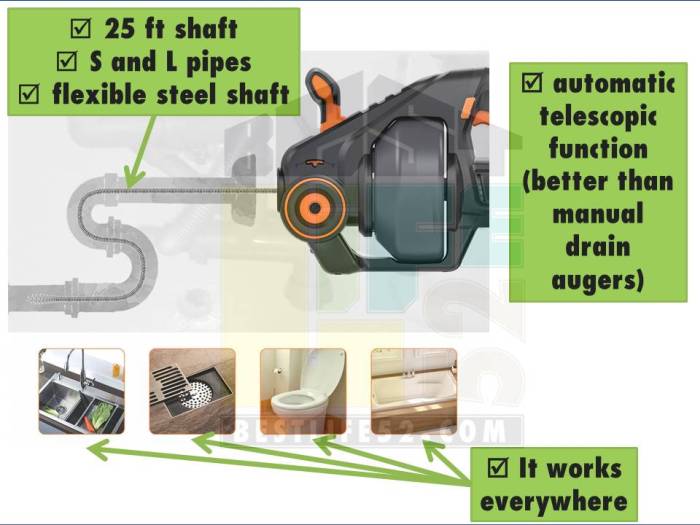Types of Plumbing Traps and How They Work
When it comes to understanding a drain, there’s a lot more going on than meets the eye. At first, it seems childishly simple. A pipe from the sink leads down through an abrupt, U-shaped “squiggle” and disappears through the wall, presumably taking all the drain water and waste with it.
When I was 8, I figured that the “squiggle,” called a P-trap (Fig. A) was a special blessing for kids with slippery fingers. If I should accidentally drop my goldfish down the drain while cleaning the fishbowl, I’d find it in the trap swimming around, if not happily, at least alive. It was some relief to know that if my best marbles, the household silverware, or my Batman ring slipped down the drain, they wouldn’t be lost. The trap was there to catch them.

A plug of water remains in the low bend in the trap alter the sink drains, sealing the pipe and preventing potentially hazardous and foul-smelling sewer gases from entering the room. The vent prevents that water plug from being sucked out.
But my childhood notion about P-traps was mostly wrong. While they do catch some dropped treasures, that isn’t their primary purpose. As simple as it looks, the P-trap is a sophisticated piece of drainage hardware. In fact, it took several generations of plumbers working through trial and error to perfect this device. In the remainder of this article, I’ll explain the critical role P-traps play in making our drain systems work.
Best Cordless Drain Auger: Tacklife HGDDC1A
This cordless drain clog remover works in your kitchen, bathroom, bathtubs, utility sinks, shower drains, and downspouts. It comes with a rechargeable battery and features an LED work light. Click here for more details.
The problem of bad odors
Draining the waste water from a sink was never particularly difficult: any downward sloping pipe would do. But doing it while keeping the smells of the sewer out of the house was the big hurdle. The same pipes that carried wastewater to the sewer system brought the stench and potentially lethal sewer gases (from rotting food, human waste, and other garbage) back into the house. For all practical purposes, bad smells kept the outhouse in business (and outdoors) well into this century.
Some early solutions simply weren’t practical. Several thousand years ago, Roman plumbers solved the problem for nobility by directing a steady stream of water through the indoor bathroom (they had two and three seaters even!). The stream was a flushing mechanism that washed the waste and smells away. Of course, this luxury required that you lived upstream. And you quickly became unpopular with the folks immediately downstream! So the idea never caught on.
When concern for better sanitation arose in England in the mid-1800s, inventors came up with many solutions for blocking sewer gas. Few solutions proved to be sanitary, but the “S-trap” stood above the rest (Fig. B). When you filled the low bend in the S-trap with water, it effectively plugged the pipe and prevented sewer gases from flowing back into the house.
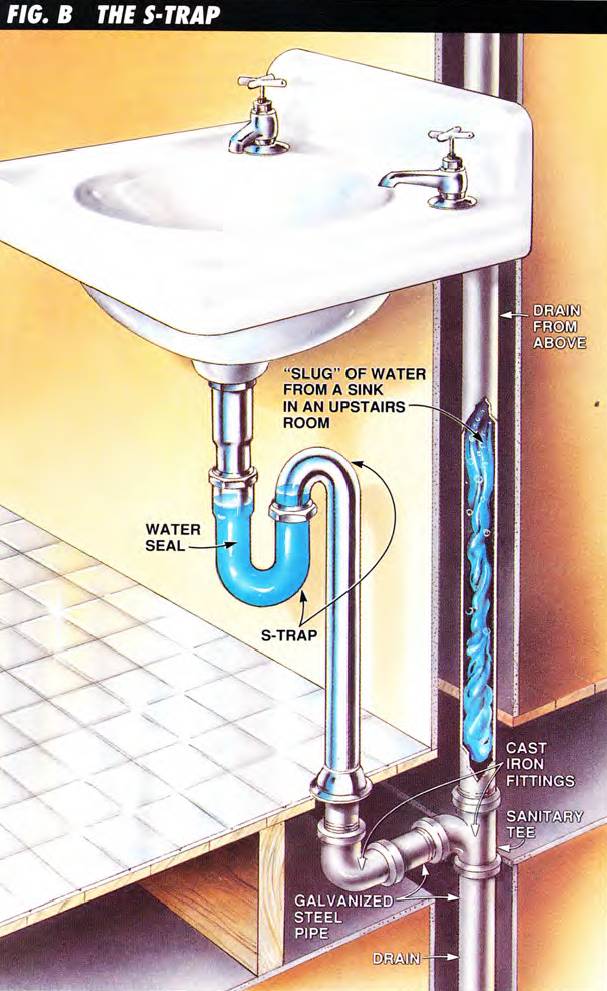
The S-trap, invented in the mid-1800s, was a big stride toward blocking sewer gases and allowing plumbing to come indoors. Unfortunately, the water seal was often sucked out by the draining water or by other waste that shared a common drainpipe.
While the theory was good, the S-trap didn’t work that well.
First of all, you couldn’t assume that it would fill automatically. Water rushing through the drainpipe created a suction that pulled most of the remaining water along with it. This suction, called “siphoning,” drew the water seal right on through the “S” bend in the pipe. So to restore the water seal, you had to remember to pour a little water down the drain after draining a sink or flushing a toilet to make sure the trap filled. You’d smell the problem if you forgot. Imagine parents sniffing the air and yelling at their kids to fill the trap!
(Is this where the expression “shut your trap” came from?)
The modern toilet works exactly on this S-trap principle. The drain in the ceramic bowl is molded in the shape of an S-trap. Once you flush the toilet, the siphoning action effectively sucks out all the waste. Then, while the tank refills, a small amount of water automatically refills the bowl and seals out the sewer gases.
Occasionally, an S-trap caused another problem called a “blow-out,” Blow-outs occurred when a charge of water (called a slug) came down a shared drainpipe (Fig. B). As the slug rapidly dropped, it compressed the air in the pipes below.
This sudden compression forced the water seal in the traps of connecting drains back up into their sinks. Then, once passed, the slug often created a suction that tended to siphon the water from traps as well.
The key invention
The solution to the siphoning problem came gradually through trial and error. Finally, a plumber, experimenting with vents in 1874, came up with the solution.
The trick to keeping the water plug in place was to equalize air pressures in the drain system. To do this, plumbers added an extra pipe to the trap that led to open air (Fig. C), a kind of pressure relief system.
They ran the pipe upward so drain water wouldn’t fill and clog it, eventually running it through the roof so sewer gases wouldn’t stink up the house The vent finally made plumbing a welcome feature inside the home and put the outhouse out of business.
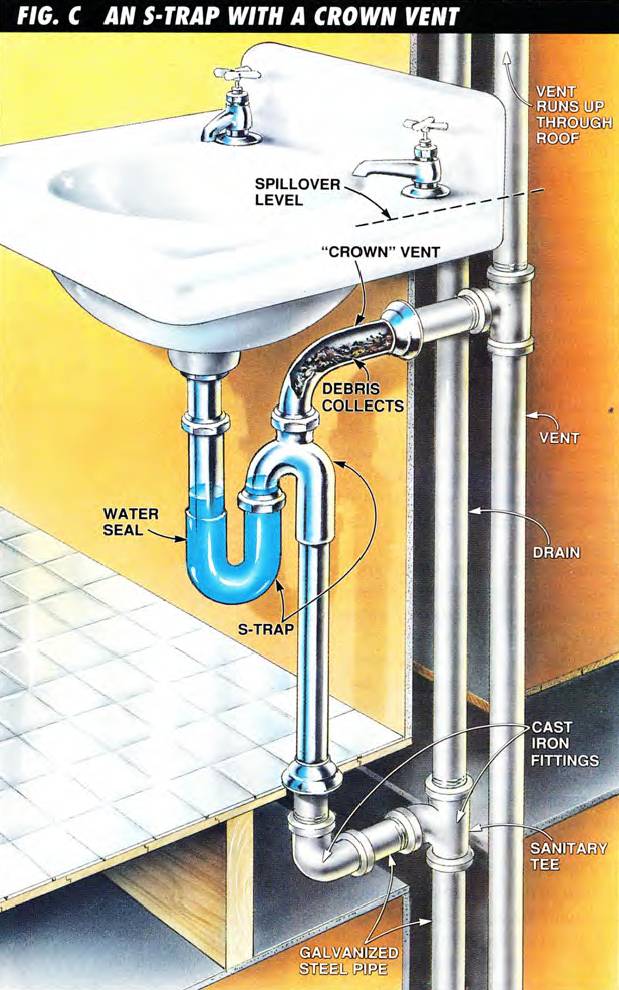
Adding a vent solved the problem of siphoning and kept the water seal in place in the S-trap. The vent tended to collect debris and plug up, however, so the vented S-trap, the standard of the early 1900s, was replaced by the P-trap.
Plumbers continued to improve the vent system, eventually developing a basic rule of plumbing: Every fixture must have a trap and every trap should have a vent.
As a result, the drain systems in our homes have about as many pipes extending upward toward fresh air as going down to drain waste.
You might never know it though because you can’t see the vents unless you have a sink in an unfinished basement, where the vent is exposed as it goes up from the waste line. Otherwise, plumbers enclose the vents in the walls.
However, if you go outside and look up at your roof, you’ll see one or more pipes, 2 to 4 in. in diameter, poking out. They might be partially or completely covered by metal flashing to prevent the roof from leaking. At least one will be large, 3 to 4 in., called the main vent or “soil stack” because it usually vents a toilet and the main sewer leading away from your house.
From S-traps to P-traps
The S-trap represented state-of-the-art drain technology in the early 20th century. Browsing through the 1910 Sears Roebuck Home Builder’s Catalog, I found the S-trap pictured on almost every sink (The Sears catalog sold every part you’d need for your home, and in fact, you could buy the precut home itself, ready to assemble!)
But over the next 25 years, the S-trap was gradually replaced by the “half S-trap” or what we now call the “P-trap,” named because it sort of looks like the letter “P” lying on its side (Fig. A).
The weakness of the S-trap lays in its venting system (Fig, C). In theory, the vent worked well enough, supplying air to prevent siphoning.
But in practice, it sometimes failed.
Every time the water in a drain slowed, say because sludge temporarily clogged the waste line, water backed up into the vent pipe.
Though it soon drained out again, the wastewater left behind oil, grease, and other debris in the horizontal section of the vent pipe. After several years, this sludge often clogged the vent, blocked the airflow, and allowed siphoning to occur in the S-trap.
Again, by trial and error, plumbers learned that the vent had to run upward to a point above the spillover line on a sink before running horizontally, so debris wouldn’t collect in the vent pipe (Figs. A and C). Plumbing officials eventually put this requirement in the plumbing codes.
The P-trap solved these problems because plumbers no longer had to connect the vent directly to the trap. If you look at Fig. A, you can see that now plumbers install the vent some distance away, conveniently back in the wall where it’s out of sight. From there the vent can run straight up, keeping it clog-free. Once the vent rises above the spill line of the fixture, it can run horizontally and join with other vents, eventually exiting through the roof.
But several problems persisted. To make the system work smoothly, plumbing engineers found that wastewater flowing between the trap and vent (in the “waste arm,” Fig. A) must move at the right speed. If it flows too slowly, it’ll leave debris behind, which will clog the pipe. But if the wastewater moves too fast, it’ll tumble, fill the pipe, block the balancing air from the vent, and siphon the water from the trap.
As a result, plumbing codes regulate this section of drainpipe closely. It should drop between 1/8 and 1/4 in. per ft. and extend no more than 42 in. (in most cases, although this figure varies with the size of the pipe) before reaching the vent. This results in the most efficient flow without siphoning water from the trap.
The sanitary tee shown in Fig. A will help you get the right slope. It’s designed so that if the vent and drain pipes are exactly plumb (straight up and down), the waste arm that attaches to it will slope 1/4 in. per ft.
Another old trap: the drum trap
You’ll rarely find an S-trap anymore; most have been replaced. But you are likely to find “drum” traps connected to bathtub drains in older homes (Fig. D). They look like a 2-lb. coffee can, made from iron, lead or occasionally brass, with a screw top or bottom. Water from the tub enters near the bottom and exits near the top, so wastewater fills the trap and creates the water plug before flowing out. Sometimes the screw-off tops were chrome-plated and left exposed in the tile floor, so you could open the trap and clean it out.
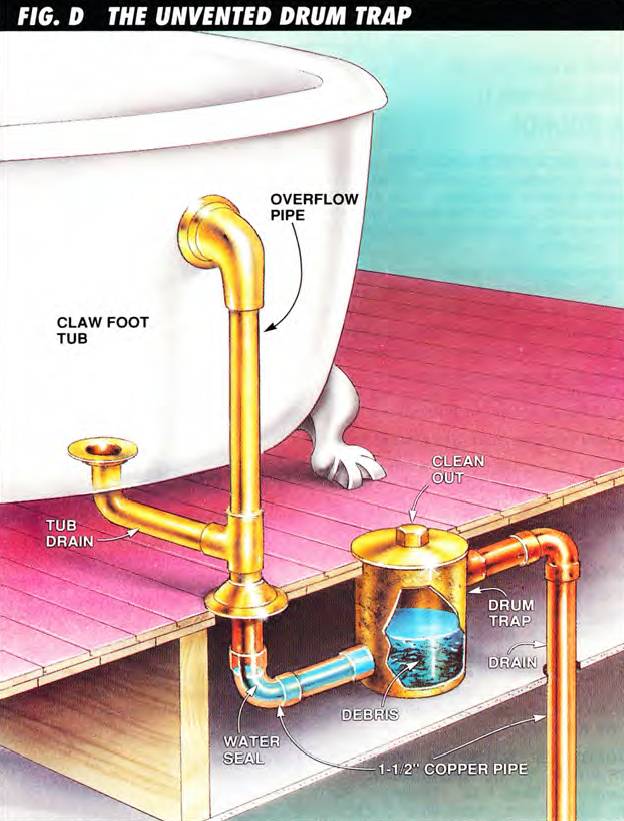
Drum traps had to be cleaned regularly. Many had no vents, even as late as the 1950s in some cases. They were usually made from lead or cast iron. The brass style with copper pipe that is shown here is a bit unusual.
The water seal didn’t siphon out as easily from drum traps, so plumbers didn’t always vent them. This saved the hassle and expense of running extra pipe, although codes eventually required a vent on most drum traps too.
Unfortunately, drum traps caused drainage problems because debris settled and collected in the trap.
If you didn’t clean them regularly, a chore that homeowners often ignored, they would solidly plug up.
And you can’t run a plumbing “snake” (a flexible wire designed to go around curves in the pipe) down through a drum trap to unclog it, because it’ll get stuck inside the drum itself. Or worse, the snake will pierce the soft sidewalls of a lead trap.
The problem of the drum trap highlights one important advantage of a P-trap (or even the old S-trap). It’s self-cleaning. Each time you pull the plug on your drain, the wastewater scours it and washes debris away. In reality, P-traps rarely clog up. Toothpaste tube tops, goldfish, and even sand generally wash right through. Of course, toothbrushes and silverware that won’t go around the bend will clog it.
Fortunately, P-traps are easy to clean. You simply loosen the two large nuts on either end and pull it off. (Keep a bucket underneath to catch water!) It’s better to trap those big objects early, where they’re easily removed than to find them stuck in a bend of the drain system that is much harder to get at. And with the P-trap removed you can easily run a snake farther down the drain to break open other blockages.
P-traps don’t solve all drain problems. The waves of stuff that we intentionally or unintentionally put through our drains — hair, sticky bath gels and soaps, grease and oils, lint, earrings, and so on — all conspire to block them up. But coupled with vents, they do their main job well. They keep the bad odors out.
Cordless Drain Clog Remover (Tacklife HGDDC1A)
It has an automatic telescopic function, unlike manual drain augers. Removing clogs becomes much easier. It pays for itself the first time you need a plumber! Click here for more details.
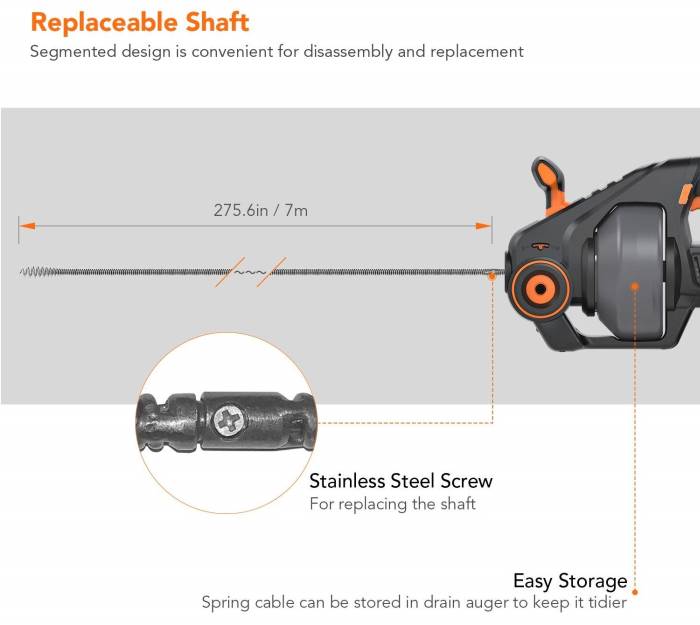
When it comes to understanding a drain, there’s a lot more going on than meets the eye. At first, it seems childishly simple. A pipe from the sink leads down through an abrupt, U-shaped “squiggle” and disappears through the wall, presumably taking all the drain water and waste with it.
When I was 8, I figured that the “squiggle,” called a P-trap (Fig. A) was a special blessing for kids with slippery fingers. If I should accidentally drop my goldfish down the drain while cleaning the fishbowl, I’d find it in the trap swimming around, if not happily, at least alive. It was some relief to know that if my best marbles, the household silverware, or my Batman ring slipped down the drain, they wouldn’t be lost. The trap was there to catch them.

A plug of water remains in the low bend in the trap alter the sink drains, sealing the pipe and preventing potentially hazardous and foul-smelling sewer gases from entering the room. The vent prevents that water plug from being sucked out.
But my childhood notion about P-traps was mostly wrong. While they do catch some dropped treasures, that isn’t their primary purpose. As simple as it looks, the P-trap is a sophisticated piece of drainage hardware. In fact, it took several generations of plumbers working through trial and error to perfect this device. In the remainder of this article, I’ll explain the critical role P-traps play in making our drain systems work.
Best Cordless Drain Auger: Tacklife HGDDC1A
This cordless drain clog remover works in your kitchen, bathroom, bathtubs, utility sinks, shower drains, and downspouts. It comes with a rechargeable battery and features an LED work light. Click here for more details.
The problem of bad odors
Draining the waste water from a sink was never particularly difficult: any downward sloping pipe would do. But doing it while keeping the smells of the sewer out of the house was the big hurdle. The same pipes that carried wastewater to the sewer system brought the stench and potentially lethal sewer gases (from rotting food, human waste, and other garbage) back into the house. For all practical purposes, bad smells kept the outhouse in business (and outdoors) well into this century.
Some early solutions simply weren’t practical. Several thousand years ago, Roman plumbers solved the problem for nobility by directing a steady stream of water through the indoor bathroom (they had two and three seaters even!). The stream was a flushing mechanism that washed the waste and smells away. Of course, this luxury required that you lived upstream. And you quickly became unpopular with the folks immediately downstream! So the idea never caught on.
When concern for better sanitation arose in England in the mid-1800s, inventors came up with many solutions for blocking sewer gas. Few solutions proved to be sanitary, but the “S-trap” stood above the rest (Fig. B). When you filled the low bend in the S-trap with water, it effectively plugged the pipe and prevented sewer gases from flowing back into the house.

The S-trap, invented in the mid-1800s, was a big stride toward blocking sewer gases and allowing plumbing to come indoors. Unfortunately, the water seal was often sucked out by the draining water or by other waste that shared a common drainpipe.
While the theory was good, the S-trap didn’t work that well.
First of all, you couldn’t assume that it would fill automatically. Water rushing through the drainpipe created a suction that pulled most of the remaining water along with it. This suction, called “siphoning,” drew the water seal right on through the “S” bend in the pipe. So to restore the water seal, you had to remember to pour a little water down the drain after draining a sink or flushing a toilet to make sure the trap filled. You’d smell the problem if you forgot. Imagine parents sniffing the air and yelling at their kids to fill the trap!
(Is this where the expression “shut your trap” came from?)
The modern toilet works exactly on this S-trap principle. The drain in the ceramic bowl is molded in the shape of an S-trap. Once you flush the toilet, the siphoning action effectively sucks out all the waste. Then, while the tank refills, a small amount of water automatically refills the bowl and seals out the sewer gases.
Occasionally, an S-trap caused another problem called a “blow-out,” Blow-outs occurred when a charge of water (called a slug) came down a shared drainpipe (Fig. B). As the slug rapidly dropped, it compressed the air in the pipes below.
This sudden compression forced the water seal in the traps of connecting drains back up into their sinks. Then, once passed, the slug often created a suction that tended to siphon the water from traps as well.
The key invention
The solution to the siphoning problem came gradually through trial and error. Finally, a plumber, experimenting with vents in 1874, came up with the solution.
The trick to keeping the water plug in place was to equalize air pressures in the drain system. To do this, plumbers added an extra pipe to the trap that led to open air (Fig. C), a kind of pressure relief system.
They ran the pipe upward so drain water wouldn’t fill and clog it, eventually running it through the roof so sewer gases wouldn’t stink up the house The vent finally made plumbing a welcome feature inside the home and put the outhouse out of business.

Adding a vent solved the problem of siphoning and kept the water seal in place in the S-trap. The vent tended to collect debris and plug up, however, so the vented S-trap, the standard of the early 1900s, was replaced by the P-trap.
Plumbers continued to improve the vent system, eventually developing a basic rule of plumbing: Every fixture must have a trap and every trap should have a vent.
As a result, the drain systems in our homes have about as many pipes extending upward toward fresh air as going down to drain waste.
You might never know it though because you can’t see the vents unless you have a sink in an unfinished basement, where the vent is exposed as it goes up from the waste line. Otherwise, plumbers enclose the vents in the walls.
However, if you go outside and look up at your roof, you’ll see one or more pipes, 2 to 4 in. in diameter, poking out. They might be partially or completely covered by metal flashing to prevent the roof from leaking. At least one will be large, 3 to 4 in., called the main vent or “soil stack” because it usually vents a toilet and the main sewer leading away from your house.
From S-traps to P-traps
The S-trap represented state-of-the-art drain technology in the early 20th century. Browsing through the 1910 Sears Roebuck Home Builder’s Catalog, I found the S-trap pictured on almost every sink (The Sears catalog sold every part you’d need for your home, and in fact, you could buy the precut home itself, ready to assemble!)
But over the next 25 years, the S-trap was gradually replaced by the “half S-trap” or what we now call the “P-trap,” named because it sort of looks like the letter “P” lying on its side (Fig. A).
The weakness of the S-trap lays in its venting system (Fig, C). In theory, the vent worked well enough, supplying air to prevent siphoning.
But in practice, it sometimes failed.
Every time the water in a drain slowed, say because sludge temporarily clogged the waste line, water backed up into the vent pipe.
Though it soon drained out again, the wastewater left behind oil, grease, and other debris in the horizontal section of the vent pipe. After several years, this sludge often clogged the vent, blocked the airflow, and allowed siphoning to occur in the S-trap.
Again, by trial and error, plumbers learned that the vent had to run upward to a point above the spillover line on a sink before running horizontally, so debris wouldn’t collect in the vent pipe (Figs. A and C). Plumbing officials eventually put this requirement in the plumbing codes.
The P-trap solved these problems because plumbers no longer had to connect the vent directly to the trap. If you look at Fig. A, you can see that now plumbers install the vent some distance away, conveniently back in the wall where it’s out of sight. From there the vent can run straight up, keeping it clog-free. Once the vent rises above the spill line of the fixture, it can run horizontally and join with other vents, eventually exiting through the roof.
But several problems persisted. To make the system work smoothly, plumbing engineers found that wastewater flowing between the trap and vent (in the “waste arm,” Fig. A) must move at the right speed. If it flows too slowly, it’ll leave debris behind, which will clog the pipe. But if the wastewater moves too fast, it’ll tumble, fill the pipe, block the balancing air from the vent, and siphon the water from the trap.
As a result, plumbing codes regulate this section of drainpipe closely. It should drop between 1/8 and 1/4 in. per ft. and extend no more than 42 in. (in most cases, although this figure varies with the size of the pipe) before reaching the vent. This results in the most efficient flow without siphoning water from the trap.
The sanitary tee shown in Fig. A will help you get the right slope. It’s designed so that if the vent and drain pipes are exactly plumb (straight up and down), the waste arm that attaches to it will slope 1/4 in. per ft.
Another old trap: the drum trap
You’ll rarely find an S-trap anymore; most have been replaced. But you are likely to find “drum” traps connected to bathtub drains in older homes (Fig. D). They look like a 2-lb. coffee can, made from iron, lead or occasionally brass, with a screw top or bottom. Water from the tub enters near the bottom and exits near the top, so wastewater fills the trap and creates the water plug before flowing out. Sometimes the screw-off tops were chrome-plated and left exposed in the tile floor, so you could open the trap and clean it out.

Drum traps had to be cleaned regularly. Many had no vents, even as late as the 1950s in some cases. They were usually made from lead or cast iron. The brass style with copper pipe that is shown here is a bit unusual.
The water seal didn’t siphon out as easily from drum traps, so plumbers didn’t always vent them. This saved the hassle and expense of running extra pipe, although codes eventually required a vent on most drum traps too.
Unfortunately, drum traps caused drainage problems because debris settled and collected in the trap.
If you didn’t clean them regularly, a chore that homeowners often ignored, they would solidly plug up.
And you can’t run a plumbing “snake” (a flexible wire designed to go around curves in the pipe) down through a drum trap to unclog it, because it’ll get stuck inside the drum itself. Or worse, the snake will pierce the soft sidewalls of a lead trap.
The problem of the drum trap highlights one important advantage of a P-trap (or even the old S-trap). It’s self-cleaning. Each time you pull the plug on your drain, the wastewater scours it and washes debris away. In reality, P-traps rarely clog up. Toothpaste tube tops, goldfish, and even sand generally wash right through. Of course, toothbrushes and silverware that won’t go around the bend will clog it.
Fortunately, P-traps are easy to clean. You simply loosen the two large nuts on either end and pull it off. (Keep a bucket underneath to catch water!) It’s better to trap those big objects early, where they’re easily removed than to find them stuck in a bend of the drain system that is much harder to get at. And with the P-trap removed you can easily run a snake farther down the drain to break open other blockages.
P-traps don’t solve all drain problems. The waves of stuff that we intentionally or unintentionally put through our drains — hair, sticky bath gels and soaps, grease and oils, lint, earrings, and so on — all conspire to block them up. But coupled with vents, they do their main job well. They keep the bad odors out.
Cordless Drain Clog Remover (Tacklife HGDDC1A)
It has an automatic telescopic function, unlike manual drain augers. Removing clogs becomes much easier. It pays for itself the first time you need a plumber! Click here for more details.


